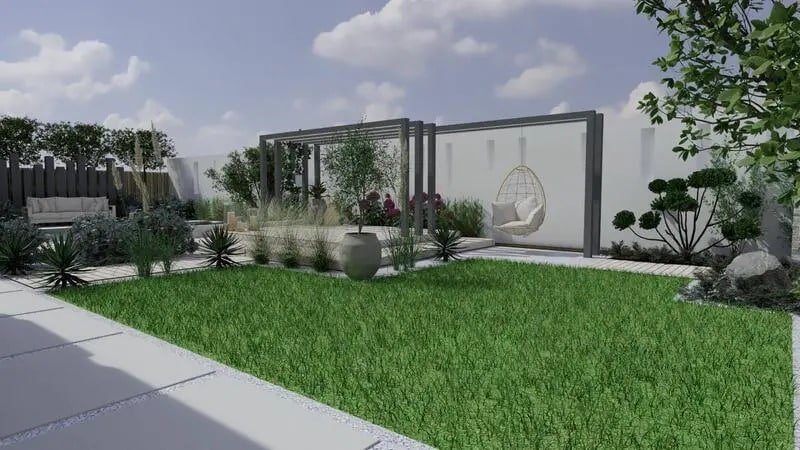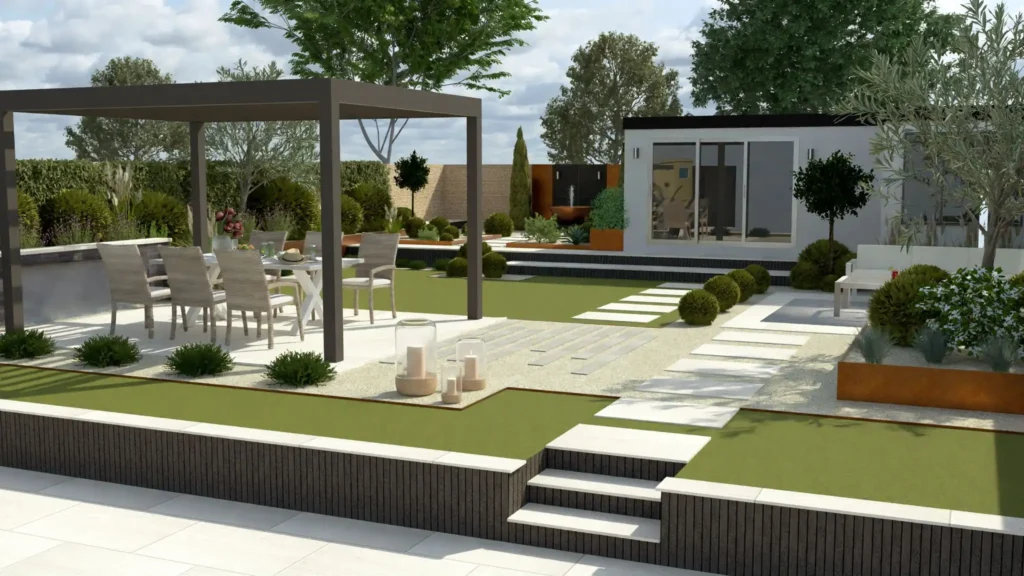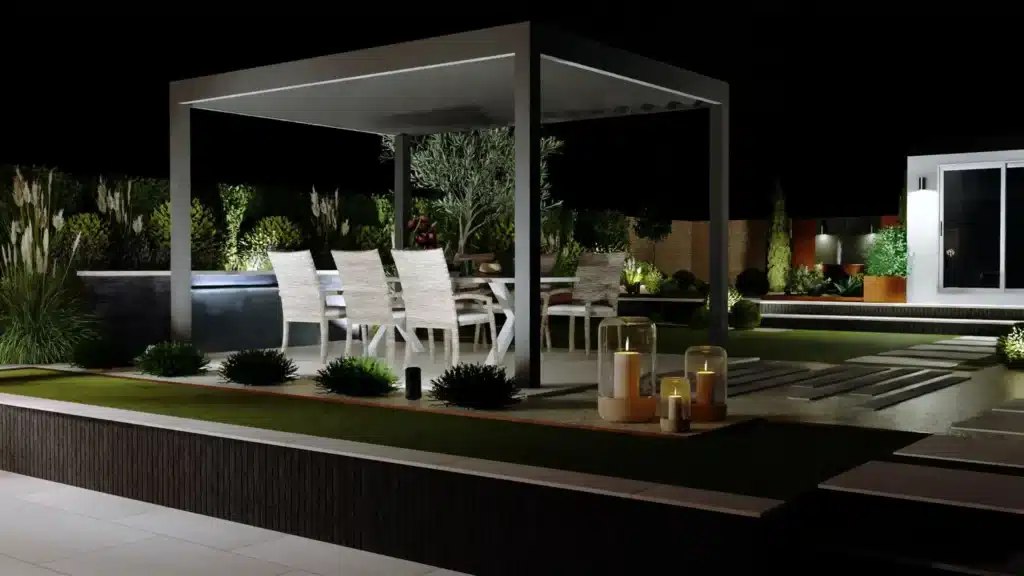Landscape gardening is the art and practice of designing, planning, and maintaining outdoor spaces with the view of it being beautiful and practical. Landscape gardening is not about laying down a flower bed or mowing a lawn. It is a very creative procedure which blends together plants, structures, design principles, and creativity to see the metamorphosis of an outdoor space into a pleasant and useful environment.
In this guide in detail, one will know what landscape gardening means, its importance, the major elements involved, and how to begin.

The General Idea of Landscape Gardening
For landscape gardening, it means beautifying and designing outside spaces like gardens, rear yards, lawns, etc. It draws and sustains a balance between natural components like plants and grass, and artificial components like paths, fences, and seating areas.
Making a space appear lovely is only one aspect of gardening. A good landscape may offer comfort and relaxation, while being useful for whatever purpose fits best. In other words, landscape gardening converts an empty plot of land into a green, pleasant, and useful outdoor area.
Why is Landscape Gardening Important?
The act of landscape gardening, most people think, is just beautification; the opportunities it presents far exceed it. Some of the main considerations for the importance of landscape gardening are listed below:
Health and Well-being
Green areas relieve stress, uplift the mood, and fill in some time for outdoor fun.
Environmental Benefits
Gardens work to make the air cleaner, support wildlife, and prevent erosion of soil.
Increase in Property Value
A well-kept landscape may greatly increase the value of a property.
Better Use of Space
The garden can be set up for family parties, as play areas, or as quiet corners.
Energy Efficiency
Another advantage trees and shrubs have is that these plants provide shade while keeping up the energy efficiency during hot times.
Main Elements of Landscape Gardening
In order to fully comprehend landscape gardening, one has to understand its first principles.

1. The Softscape: The Living Elements
Softscape may be termed the living components of a garden. These are:
- Trees
- Shrubs
- Grass
- Flowers
- Vines
The softscape is what infuses life, colour, and freshness into gardens. The selection of plants varies with the climate, types of soil, and design theme of the garden.
2. The Hardscape: The Non-Living Elements
Hardscape grades the artificial non-living stuff in the garden. Let’s consider a few examples:
- Paths and walkways
- Patios and decks
- Stone walls or fences
- Pergolas and gazebos
- Fountains
Hardscaping gives structure and purpose to the garden; without it, the landscape may appear incomplete.
3. Lighting and Water Features
Outdoor lighting accentuates the garden’s beauty after dark and enhances security. Water features like ponds, fountains, or artificial waterfalls breathe an aura of calmness into the setting.
4. Design Principles
Landscape gardening follows certain design principles such as balance, proportion, harmony, and contrast, all of which combine to make the garden look pleasing to the eye and well-organised rather than messy or cluttered.
Benefits of Landscape Gardening
Landscape gardening is not just about visual appeal; it also comes with various advantages.
- Improves Mental Health – Being surrounded by greenery can help reduce stress and promote relaxation.
- Supports the Environment – Plants help clean the air and provide shelter to birds, bees, and insects.
- Creates Social Spaces – Gardens provide areas for families to hang out or host get-togethers.
- Boosts Curb Appeal: A well-maintained garden can turn any property into the fine pride of any neighbourhood.
- Promotes Outdoor Living – Given the seating and shade, people would gladly soak in the fresh air.
How to Start Garden Landscape
Here are some simple steps if you want to create a landscaped garden of your own:

Step 1: What Do You Want to Use the Garden For?
Does the garden need to be used as a playground for children, a restful area for reading, or a garden of flowers?
Step 2: Choose the Right Plants
Plants for a garden should suit your local climate and soil conditions. This shall make upkeep easier.
Step 3: Add Hardscape Elements
Pathways, a small patio, or a seating area will work. They provide functionality to the structure.
Step 4: Be Smart with Lighting and Water
The atmosphere is cosy with outdoor lights, while water features calm it down. Keep it simple if you are working with a tight budget.
Step 5: Maintenance
Watering, pruning, and cleaning. This kind of attention will ensure that your landscape will endure through time.
Example of Gardens Landscaping
Imagine a backyard with a green lawn stretching in the middle, flanked on all sides by flowerbeds, a stone pathway leading to a wooden bench, and a small pond filled with joyful fish. This garden is softly lit when the darkness drapes over it. It is that perfect imprint of Landscape gardening where nature meets design.
Common Types of Landscaping Garden
Types of landscape gardening vary from taste to culture:
- Formal Landscape Gardening – Works with symmetry, straight lines, and neat shapes.
- Informal Landscape Gardening – Has to do with natural flow, with curved lines and mixed plants.
- Japanese Landscape Gardening: Incorporates stones, water, and a minimum of plants for calmness.
- Modern Landscape Gardening: Clean lines, open spaces, and simple plants combine for a sleek look.
Cottage Garden Style– Filled with colorful flowers in a natural, cozy setting.
Frequently Asked Questions
What is the difference between gardening and landscape gardening?
Landscape gardening is considered the planting and caring of plants. The other side of the spectrum sees landscape gardening as a more inclusive term, using both plants and structures for designing the outdoors.
Can I be my own landscape gardener?
Sure, start on a small scale: plant flowers, arrange stones, and create a simple seating area. For big projects, it really is safer to hire the experts.
Does landscape gardening really add value to the property?
Yes, property alteration experts state that, depending on good landscaping design, property value can increase between 15 and 20 per cent.
What types of plants are used in landscape gardening?
It depends on what climate it grows in. In most gardens, evergreen shrubs, seasonal flowers, and shade trees are among the top choices.
Conclusion
Landscape gardening is designing and maintaining the exterior ambience in such a way that it is both beautiful and useful. It hands over plants, hardscape elements, lighting, and design concepts toward crafting gardens that provide shelter, nature, and functions.
In designing a landscape, they are always considered investments, whether it is to build a small personal garden or to create a grand outdoor design. Landscaping improves health, assists with environment conservation, and raises the price of a property while adding charm to any building. If well-planted and well-maintained, good landscaping can be enjoyed by all.
